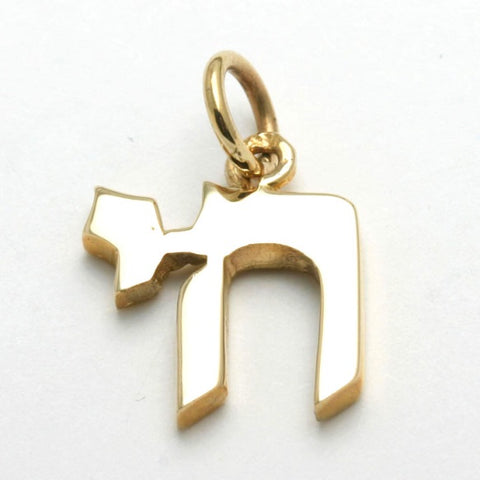Ten Common (and Less Common) Jewish Jewelry Motifs Explained
As one would expect from a nearly 4,000 year-old culture, Judaism is full of religious symbols and iconography. Many of these motifs are commonly used in Jewish art and jewelry. Below we explore some of the most common (and less common) Jewish jewelry motifs. These motifs are sometimes used individually but are often combined with one another in beautiful and original ways…
1. Star of David
The Jewish Star is the most popular symbol associated with Judaism around the world and perhaps the most popular motif for Jewish jewelry. Also called a "Magen David," or "Shield of David," the symbol is said to originate from the shield of the Israelite King David, though its actual origins are not completely clear. In fact, the Jewish Star is a relatively young Jewish symbol and its popular use only dates back a few hundred years. There are many symbolic and Mystical theories about the theological significance of the shape of two intertwined triangles.
Jewish Star of David Pendant
2. Mezuzah
Jews are commanded to affix mezuzahs to their door posts to remind them of G-d's presence and commandments in their daily lives. A mezuzah is actually a handwritten parchment paper inscribed with Torah verses. This parchment (klaf) is then rolled up and placed inside the familiar decorative (and protective) case we typically see. Mezuzah cases often prominently feature the Hebrew letter “shin,” or the word “Shaddai,” one of the names of God, and an acronym meaning “Guardian of the doors of Israel.”
The mezuzah has become a strong symbol of divine protection in Judaism. As such, the mezuzah is a popular motif for jewelry, however, one does not find a “kosher,” handwritten klaf in a mezuzah pendant.
Mezuzah pendant with "shin" and Jewish Star
3. Hamsa
The Hamsa, meaning “five” in Arabic, is a hand-shaped symbol that has significance to Jews, Muslims and many Christians. It is a common amulet among North African and Middle Eastern cultures that is said to ward off the evil eye and offer protection. It is a very popular good luck charm and often incorporates other motifs, such as an eye, chai or star.
Hamsa pendant with eye motif
4. Chai
Chai is the Hebrew word for “living,” made up of the letters “chet” and “yod.” The word is a popular symbol in Judaism. Interestingly, the Hebrew numerology of the letters that spell the word correspond to the number 18, making 18 a significant number in Jewish gift-giving. Both the chai motif and the number 18 represent long life and prosperity and the chai has become a popular jewelry motif.
A gold chai pendant
5. Ten Commandments/Torah
According to Jewish Tradition, God gave the Ten Commandments and Torah to Moses and the Israelites at Mt. Sinai soon after their exodus from Egypt. The Torah, the core of the Jewish faith, consists of the written Torah as well as the Oral Law, a tradition passed down for many centuries before being written as the Mishnah.
As such, it is not uncommon to see Jewish Jewelry motifs that depict the Ten Commandments or a Torah scroll as a representation of the theme of Torah, the central aspect of Jewish faith and tradition. Of course, the Ten Commandments is also a popular Christian design motif.
Ten Commandments tablets pendant
6. Shema Yisrael
The word “Shema” is the Hebrew imperative form of the word “hear” and “Yisrael” is the Hebrew for “Israel.” “Hear, Israel…” is the beginning of a section of Torah that is also a central Jewish prayer recited twice daily. The complete first line reads: “Hear, Israel, The Lord is our God, The Lord is one.” The prayer is an affirmation of one God and the acceptance of God’s commandments. The Shema passage is also written in the mezuzah.
Shema Yisrael pendant in the style of a flame
7. Menorah
The menorah was a seven-branched ritual candelabrum constructed of pure gold by the Israelites after the exodus from Egypt. It was used in the worship of God in the wilderness and later, in the Holy Temple in Jerusalem. Prior to the emergence of the Jewish Star, the menorah was probably the most widely used Jewish symbol.
Menorah pendant
The words “Ani Le’dodi Ve’Dodi Li” come from the Biblical book Song of Songs (or Song of Solomon). The translation is “I am my beloved’s and my beloved is mine.” The book consists of descriptive poetic expressions of passion between lovers, taken traditionally as an allegory of the love between God and Israel.
Today, this passage is very popular for some as an expression of love between a husband and wife and some Jewish women choose to speak these words to their husband on their wedding day. It is also sometimes depicted on pendants and inscribed on wedding bands.
Ring engraved with Hebrew "Ani Le'dodi"
9. Dove
Since the story of Noah and the great flood that nearly destroyed the world, the dove has been a universal symbol of peace and hope. Many people around the world embrace the dove as an expression of optimism for a better future. In Jewish jewelry, the symbol is often combined with other motifs, such as the Star of David or hamsa.
Dove and Star of David pendant
The theme of the Land of Israel, and more specifically Jerusalem (sometimes referred to as Zion), has been a common theme within Jewish culture and art for millennia, especially for diaspora Jews who longed to return to the Promised Land. Sometimes Jerusalem is represented in jewelry form as the Kotel, Wailing Wall or Western Wall, a remnant of the Jewish Temple perimeter wall in Jerusalem and a symbol of redemption.
Western Wall-themed pendant with Star of David
Star of David pendant with the Hebrew word "Zion"













Leave a comment